23 Best Apps for Learning Italian & How to Choose the Right One
.jpg%3F2025-11-04T09%3A11%3A45.744Z&w=3840&q=100)
Michael Xing, Founder of Pingo AI
When you want to learn Italian, the number of top language learning apps can feel overwhelming while you juggle work, travel plans, and everyday life. Are you looking for app-based Italian lessons that build vocabulary, sharpen pronunciation, explain grammar clearly and give real speaking practice? This article compares popular language learning tools, including Pingo AI, Duolingo, Babbel, Pimsleur, Memrise, and Busuu, highlighting key features such as flashcards, spaced repetition, listening practice, and tutor support. It also shows how to choose the right app for beginners, intermediate, and advanced learners.
To help you pick and progress, Pingo AI offers an AI language learning app that personalizes short lessons, gives instant feedback on pronunciation, and connects you to conversation practice so you meet your goals.
Summary
- The Italian learning landscape features 23 practical apps to choose from, and demand is tangible, with the top app surpassing 1.5 million downloads and users reporting a 40% increase in proficiency after just three months.
- Interactive, gamified features matter, with 80% of language learners preferring apps that include interactivity and gamification, which helps explain why these mechanics increase practice frequency.
- Adaptive, error-driven practice is essential, since 75% of regular language app users reported improved proficiency, indicating that systems that adjust to mistakes deliver measurable gains.
- Live, native-speaker interaction speeds progress, with 70% of learners saying practice with native speakers accelerates acquisition, so real conversational exchanges should be part of a learning plan.
- Consistent, measurable routines outperform sporadic study, as learners who dedicate at least 30 minutes a day improve about 50% faster, showing that short daily sessions compound into real skill.
- Practical constraints drive retention, not polished design, because over 60% of language learners use mobile apps to study, making offline support, reliable recording, and clear subscription terms critical for sustained use.
- This is where Pingo AI's AI language learning app fits in, addressing gaps in speaking practice by offering conversation-first sessions, instant corrective feedback, and scenario-driven Tutor Mode.
23 Best Apps for Learning Italian
1. Pingo AI

Pingo AI focuses on speaking from day one, utilizing expressive AI to conduct realistic conversations rather than drilling isolated words. It adapts in real-time, provides corrective feedback on pronunciation and phrasing, and offers modes for both beginners and advanced learners, allowing you to practice at the right difficulty level. If your priority is fast, confident speaking rather than passively memorizing vocabulary, this is the app to test first.
2. Babbel
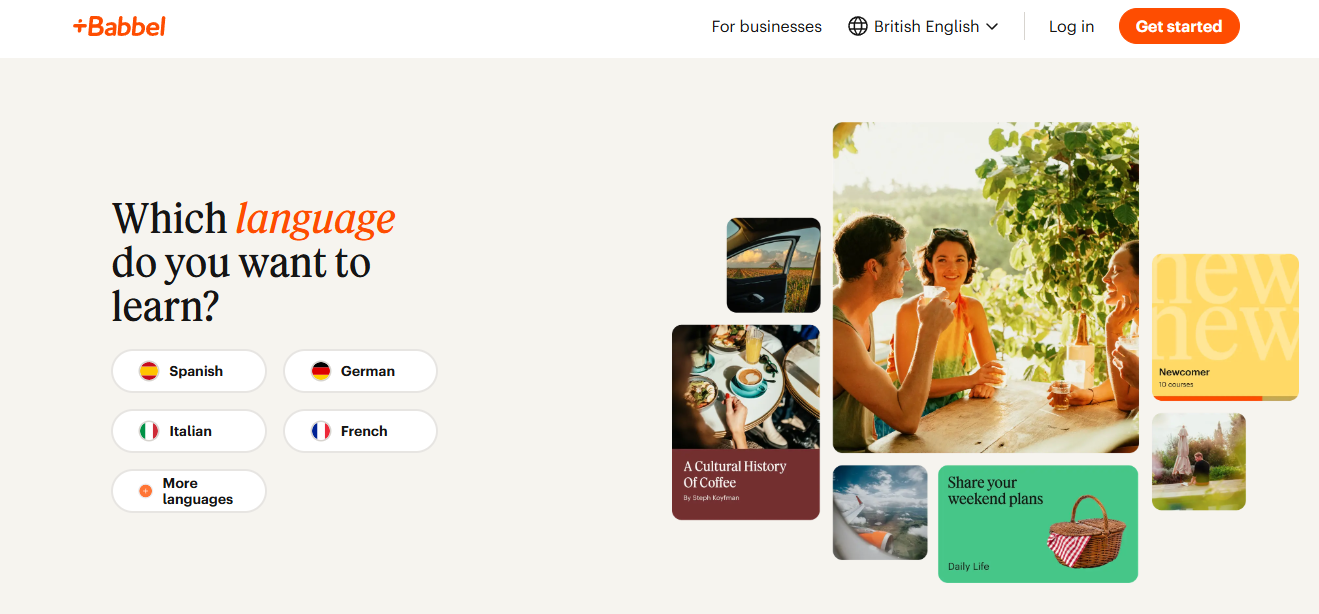
Babbel builds lessons around real-life conversation and Italian culture, with courses mapped to A1–B2 CEFR levels and materials created by experienced teachers. It combines grammar explanation, interactive practice, and cultural context, and offers a dedicated professional track for business Italian. Use Babbel when you want structured progression with a practical dialogue focus.
3. DuoLingo
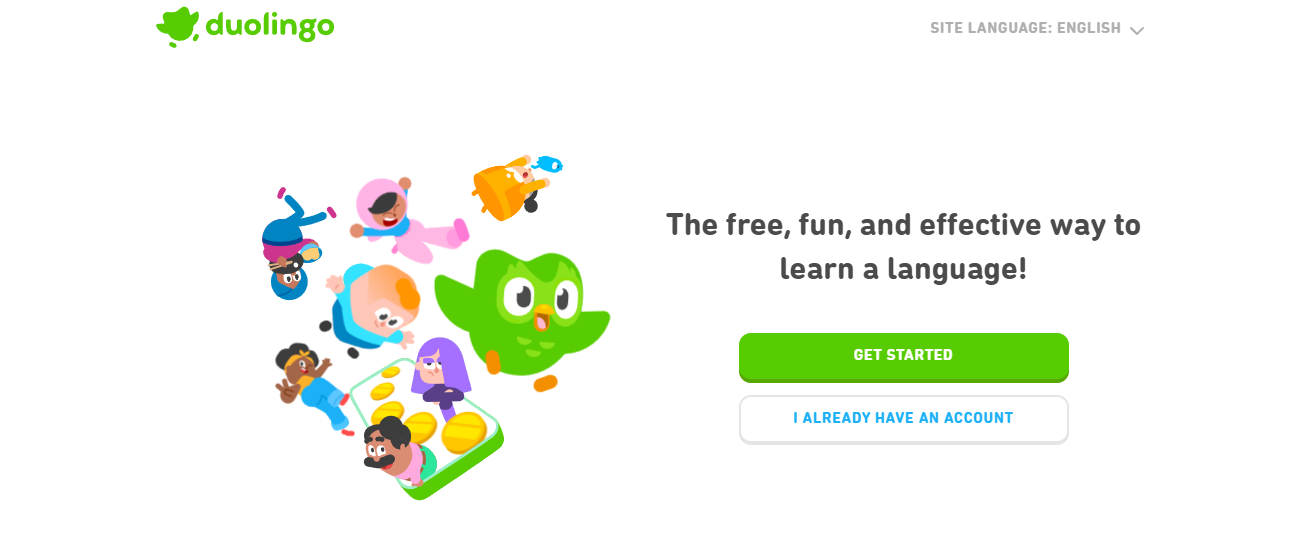
Duolingo is the go-to low-friction starter, offering short lessons, gamified rewards, and an effective microlearning cadence that makes daily practice simple. It teaches high-frequency vocabulary quickly, although some sentences may feel artificial if your goal is purely conversational fluency. Try Duolingo to build momentum with minimal time investment.
4. Memrise
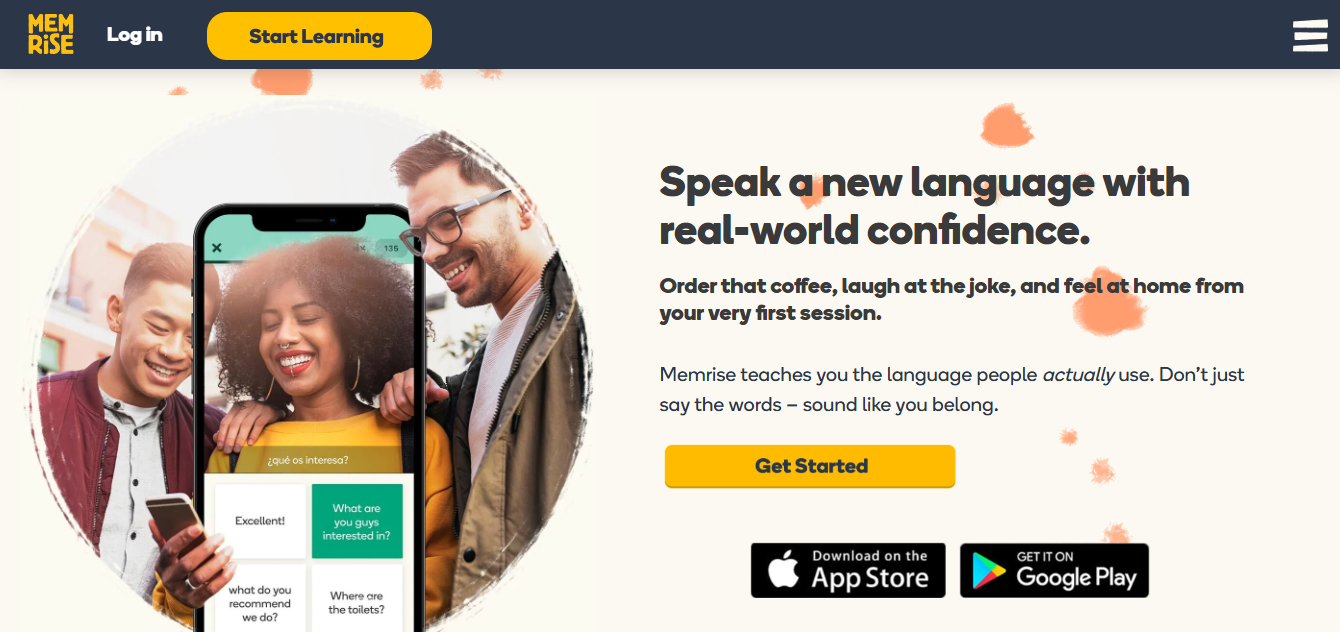
Memrise blends AI personalization with thousands of native-speaker videos, which is ideal if you want exposure to authentic accents and natural speech. It uses adaptive review and contextual clips that help you hear how Italians actually talk. Choose Memrise if listening to native intonation and authentic phrases matters to you.
5. Pimsleur
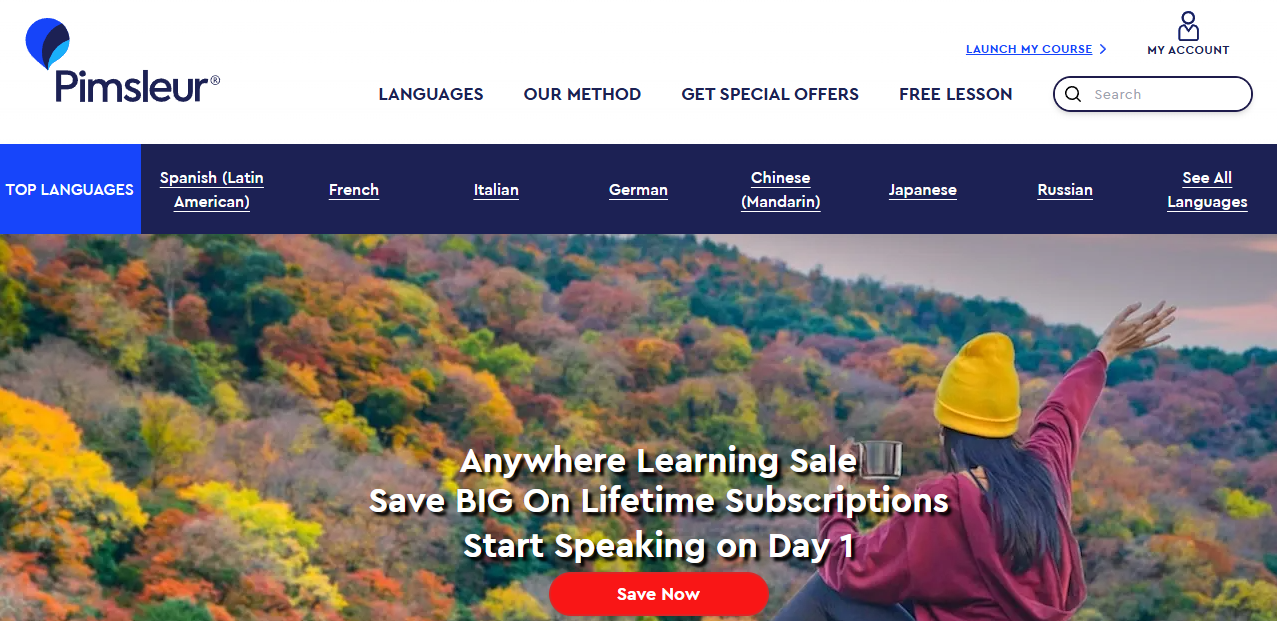
Pimsleur employs a long-established audio-first method that trains recall and spoken response, recommending approximately 30 minutes a day to build progressive skills. Its strengths are structured oral practice and spaced repetition built into dialogues. If you learn best by listening and repeating, Pimsleur provides a structured path to intermediate proficiency.
6. Mondly

Mondly adds gamified lessons and a community angle, which helps mid-level learners expand vocabulary and practice tenses while competing with peers. The app is best suited for learners who already know the basics and want varied exercises, as well as social motivation. Expect a polished interface with steady vocabulary growth.
7. FluentU

FluentU teaches through subtitled videos drawn from movies, news clips, and trailers so you learn vocabulary in context and tone. Each clip links to interactive vocab and quizzes, making it effective for comprehension and idiomatic usage. Pick FluentU if you want to learn by watching authentic material rather than through drill exercises.
8. Busuu
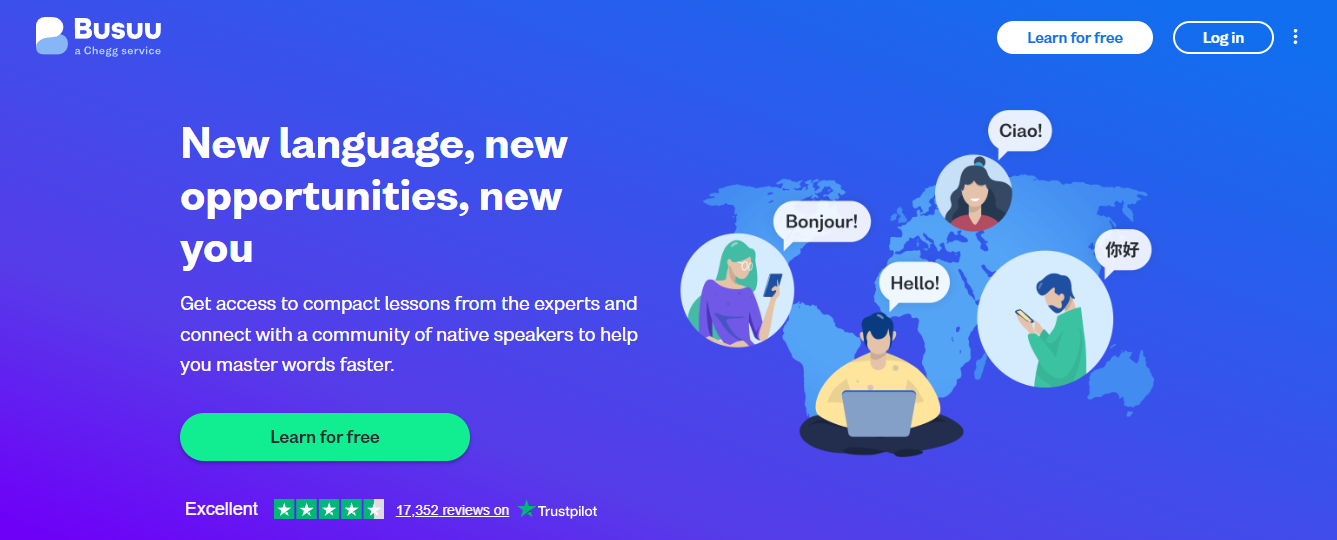
Busuu offers straightforward lessons plus the ability to get written work corrected by native speakers, which is a genuine advantage for composition practice. The app’s structure is efficient for beginners and includes an accredited certificate upon completing a course. Use Busuu when peer feedback and practical writing skills matter.
9. Italki
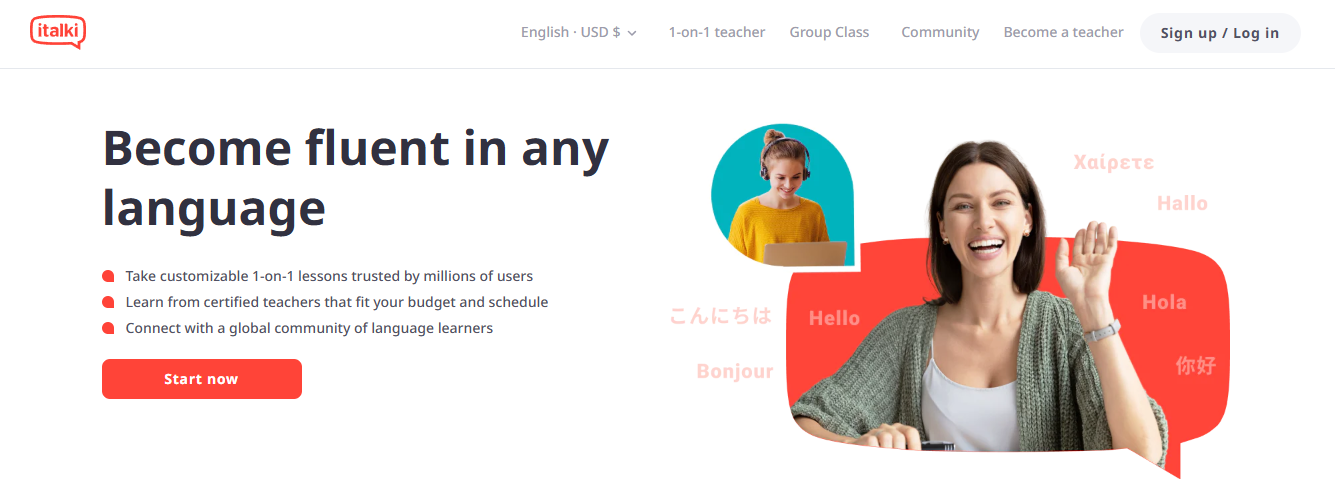
Italki connects you directly with native tutors for one-on-one lessons, priced per teacher, so you can tailor the content and pacing to your goals. It is best when you need human correction, nuanced feedback, or specialized lessons, such as in-depth grammar reviews, conversation practice, or exam preparation. Reserve Italki for targeted speaking practice once you’ve built a basic foundation.
10. Tandem
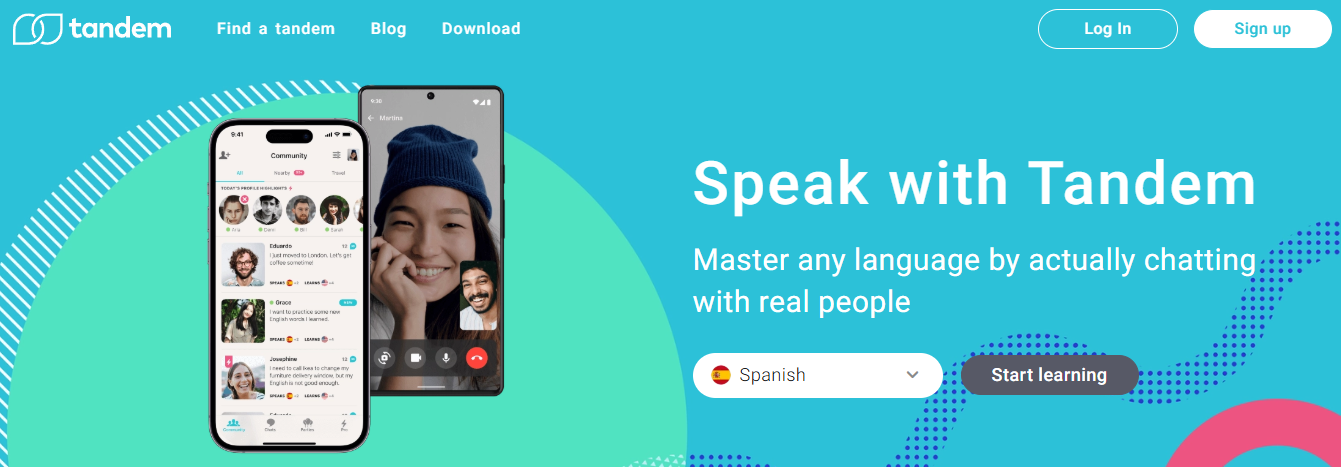
Tandem is a language-exchange platform where you pair with native Italian speakers and trade lessons, which gives you free conversational time and cultural exchange. It works best for learners who are comfortable with informal practice and mutual correction. Use Tandem to build conversational confidence without a financial barrier.
11. Ling App
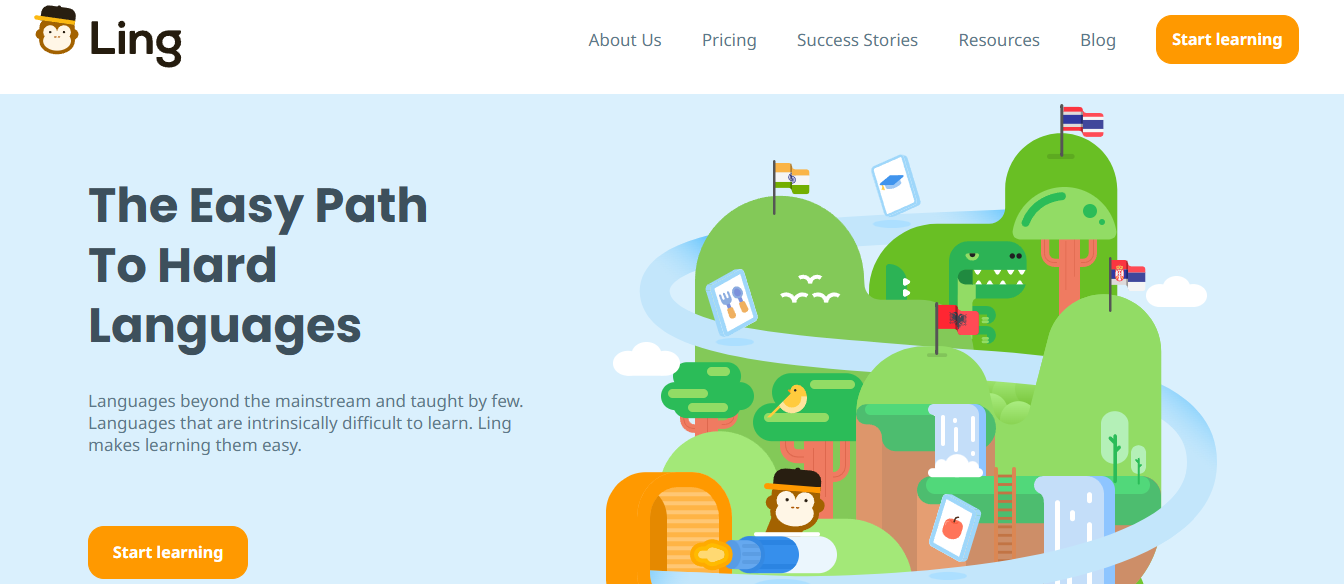
Ling App packages modular lessons across grammar, listening, speaking, and spaced exercises with a chatbot for pronunciation practice. Each module contains many short activities and reminders, which makes it flexible for microstudy sessions. Choose Ling if you want a comprehensive, all-in-one app with strong structure.
12. Rocket Languages

Rocket Languages offers in-depth, step-by-step audio lessons, voice recognition, and cultural notes, a format designed for deliberate study and progressive improvement. It includes explanations of grammar and practice dialogues that simulate everyday interactions. Use Rocket Italian if you want a classroom-style course you can work through independently.
13. MosaLingua
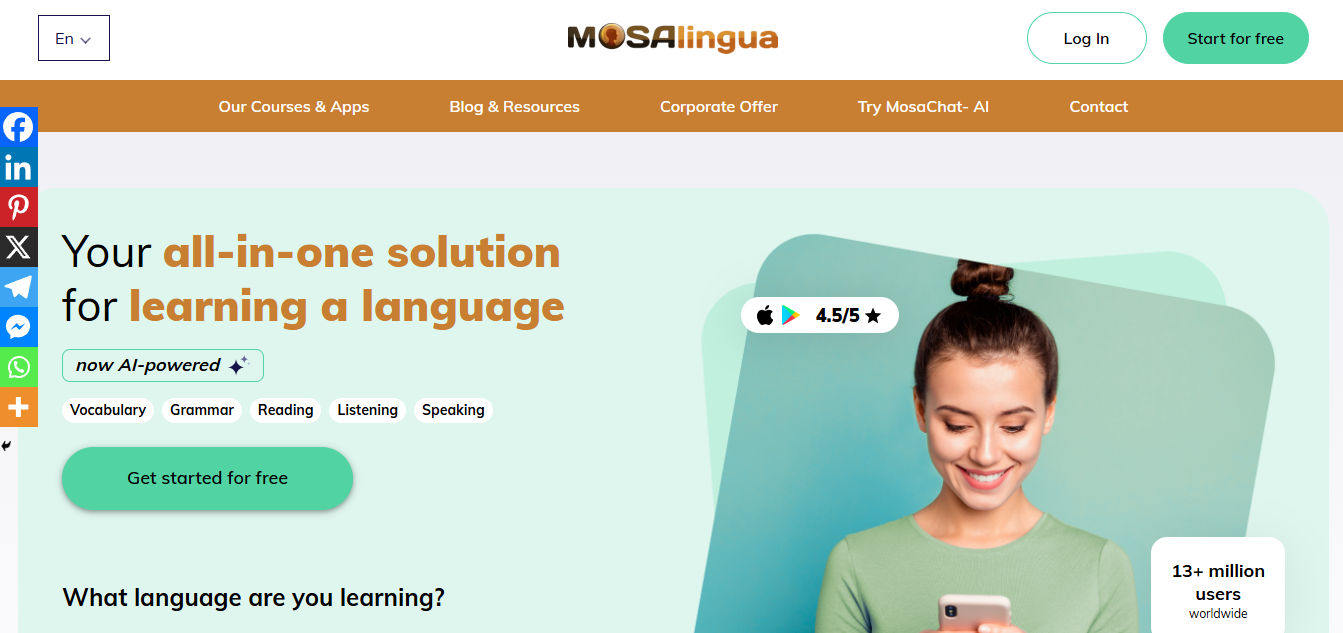
MosaLingua utilizes spaced repetition and a comprehensive set of flashcards, complemented by multimedia resources such as songs and stories, to create an immersive vocabulary system. It also allows you to customize learning plans for goals such as travel or business. Turn to MosaLingua when you need fast, practical vocabulary retention with adaptive review.
14. News In Slow Italian
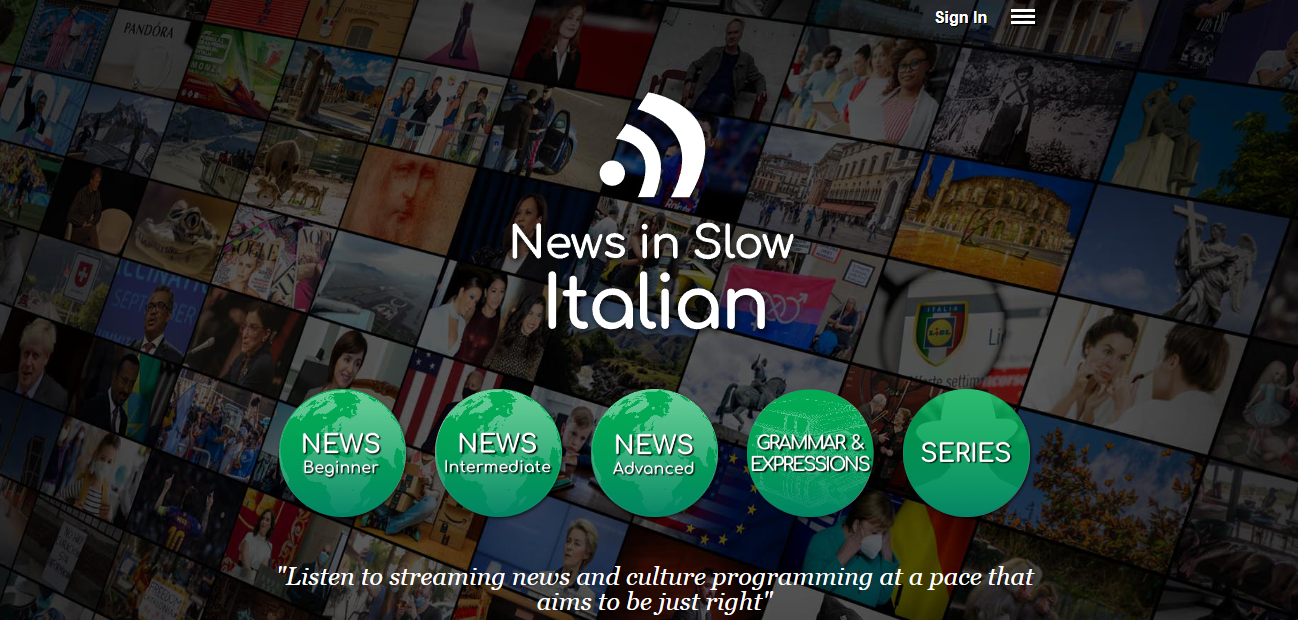
News in Slow Italian turns current events into listening practice by slowing the speech to a comprehensible pace while maintaining authentic journalism content. It is ideal for intermediate learners who want to boost listening comprehension and stay informed. Use this when you want immersion tied to a specific topic.
15. Clozemaster
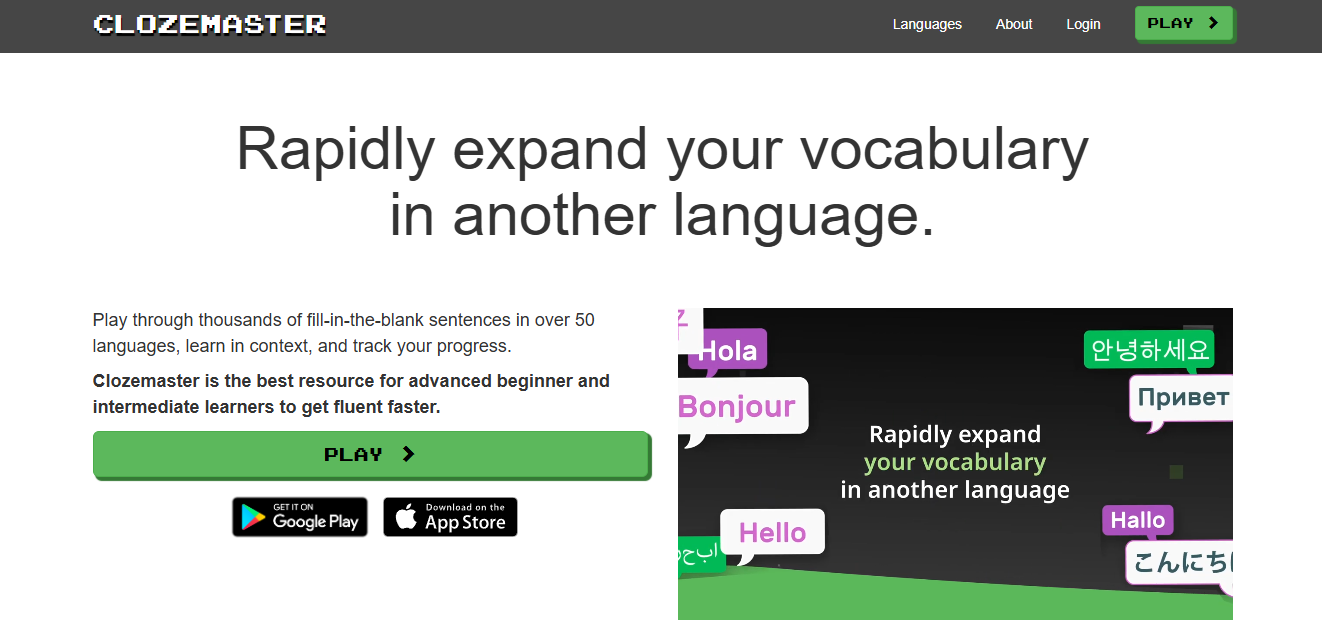
Clozemaster treats vocabulary learning like a video game, using cloze (fill-in-the-blank) sentences across thousands of contexts with spaced repetition. It is excellent for learners who enjoy competitive streaks and frequency-based vocabulary practice. Choose Clozemaster to deepen your contextual vocabulary quickly.
16. Italian Translator +
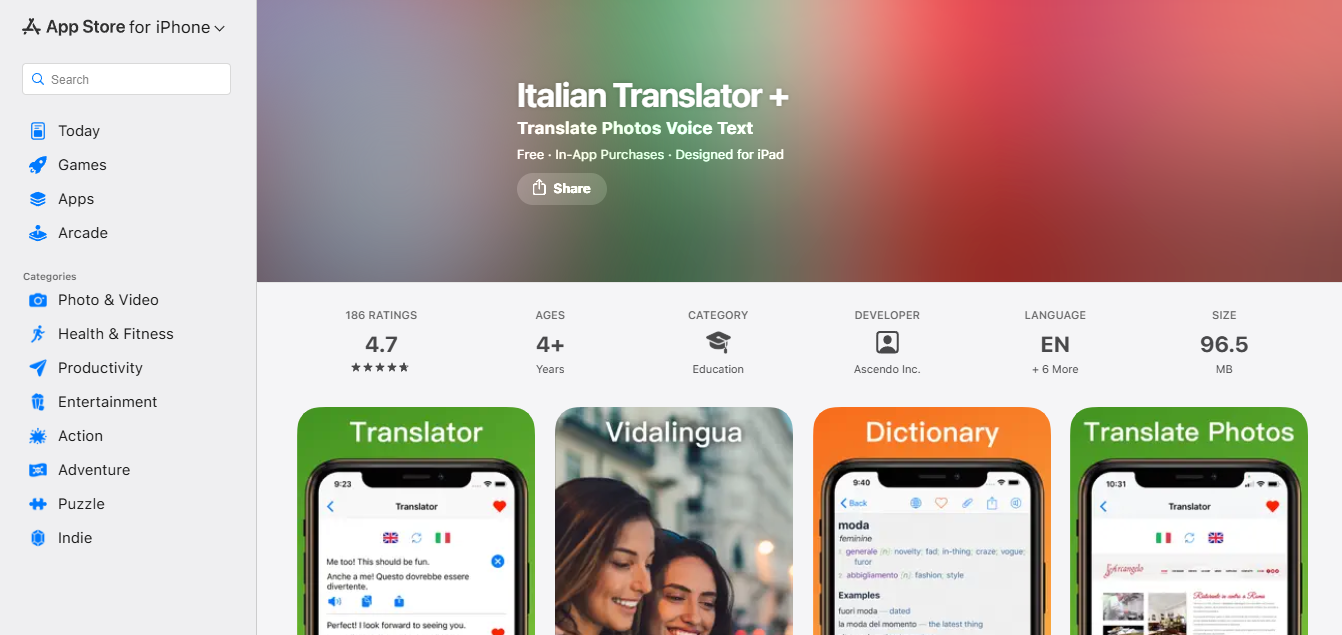
Italian Translator + doubles as a practical travel tool and a learning aid, featuring keyboard, speech, and photo translation modes, as well as a massive verb conjugation database. Its offline functionality and phrasebook are helpful when you need instant help on the street or in a restaurant. Use this app as your personal interpreter when traveling.
17. Lingopie

Lingopie teaches through TV shows and YouTube videos, allowing you to click on any subtitle word for instant translation and repeat listening, which naturally builds recognition. There is also a kid-friendly version available. Choose Lingopie if learning via storytelling and episodes keeps you engaged.
18. Rosetta Stone
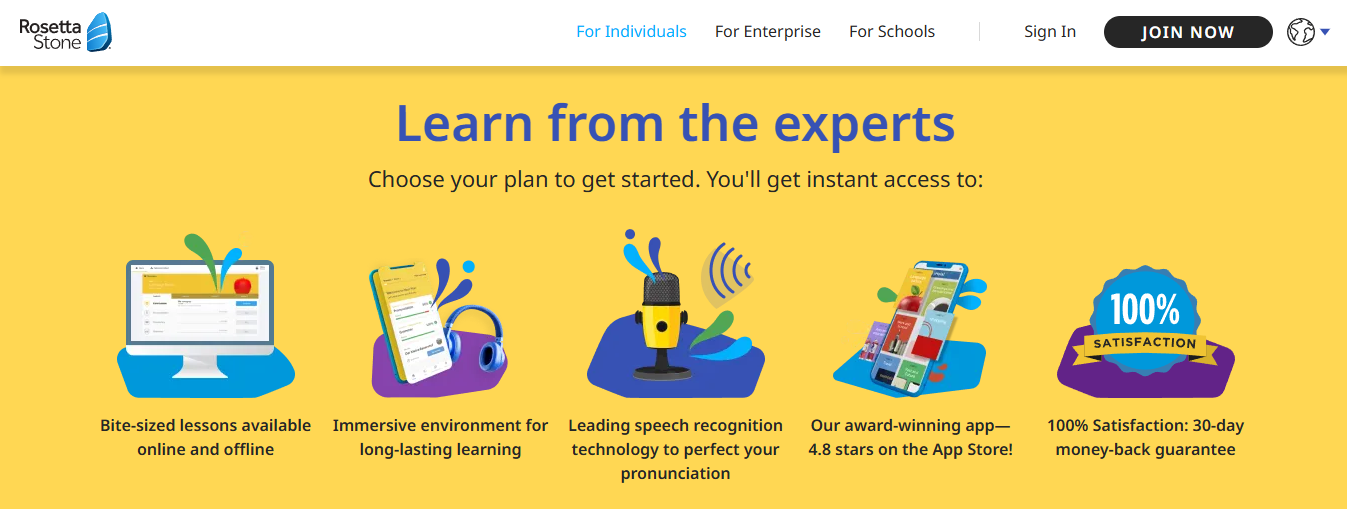
Rosetta Stone remains focused on immersion, teaching through pictured contexts and speech recognition to build an intuitive sense for the language. It offers subscription terms that cater to both short and long commitments, and emphasizes learning without translation. Use Rosetta when you want immersive, image-driven lessons with disciplined practice.
19. Ouinolanguages

Ouinolanguages centers on practical dialogues and speech recognition feedback tailored to Italian, with a clean interface for everyday scenarios. Its strength is targeted conversational practice with pronunciation coaching. Try Ouinolanguages if you want scenario-driven speaking drills and immediate feedback.
20. Drops
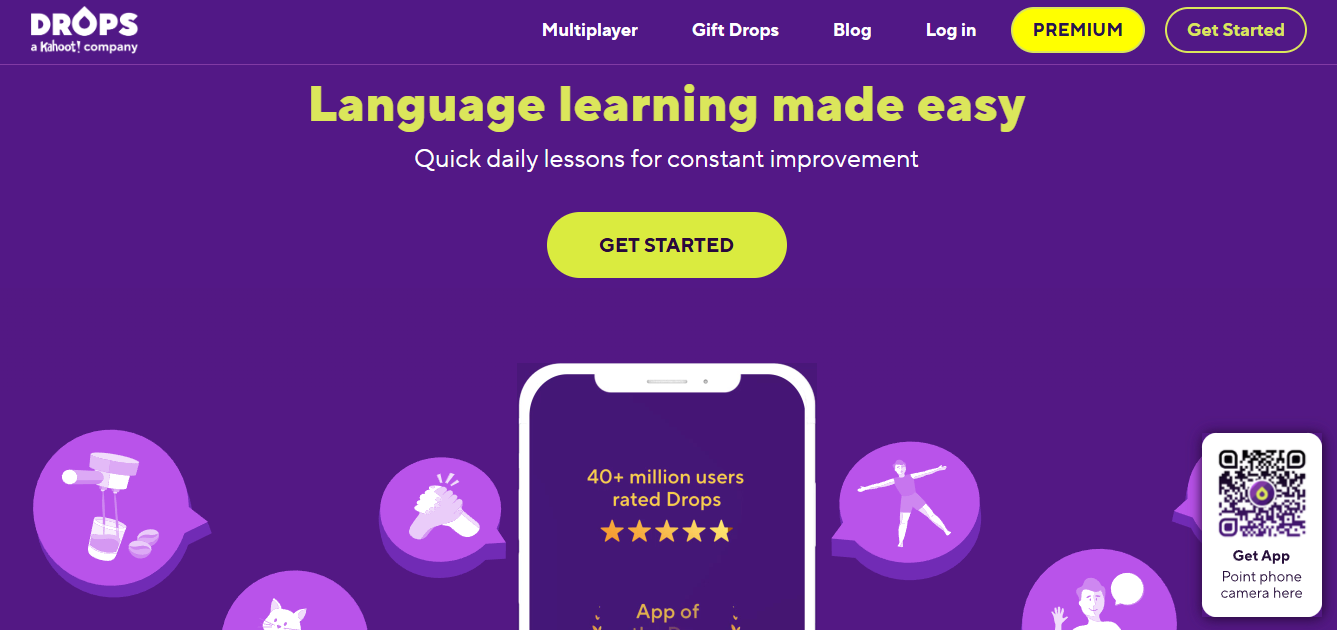
Drops teaches vocabulary through quick, visual mini-games and colorful cards, making repeated short sessions feel effortless and fun. It is highly effective for growing active word recall when you only have a few spare minutes each day. Use Drops for daily vocab bursts that stick.
21. Beelinguapp
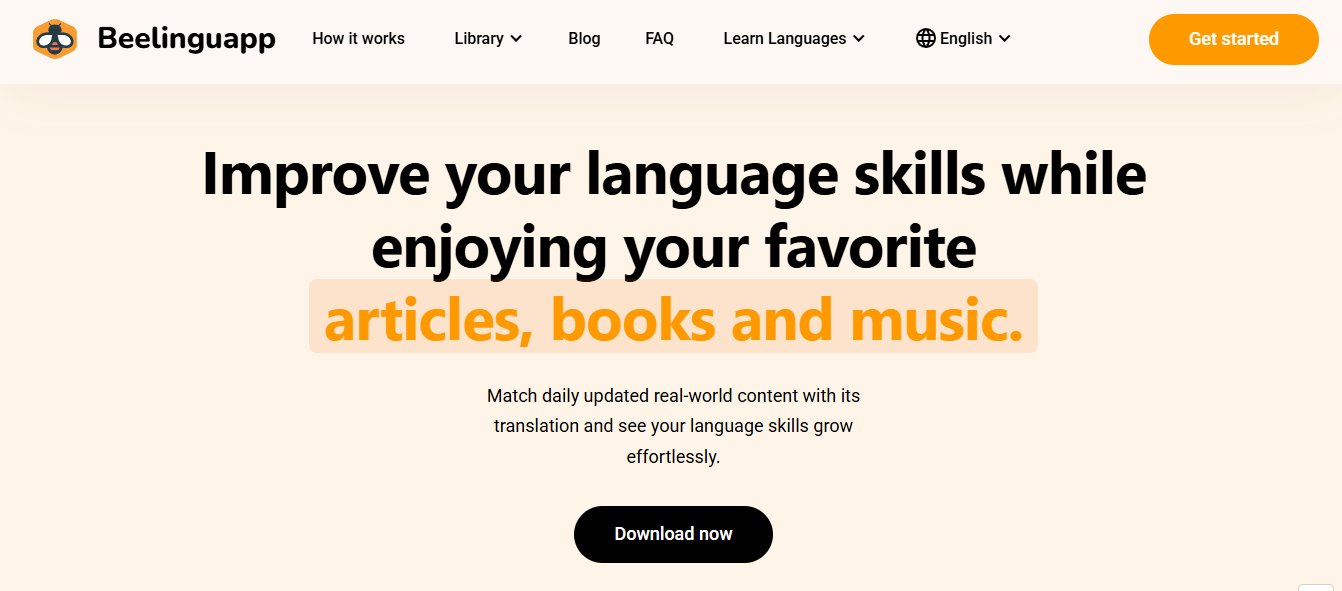
Beelinguapp teaches through bilingual reading and audio, offering audiobooks, news, and stories read by native speakers, allowing you to learn pronunciation and comprehension while enjoying the content. It pairs reading with flashcards to consolidate vocabulary. Choose Beelinguapp to combine literacy with listening practice.
22. Rocket Italian (listed again)
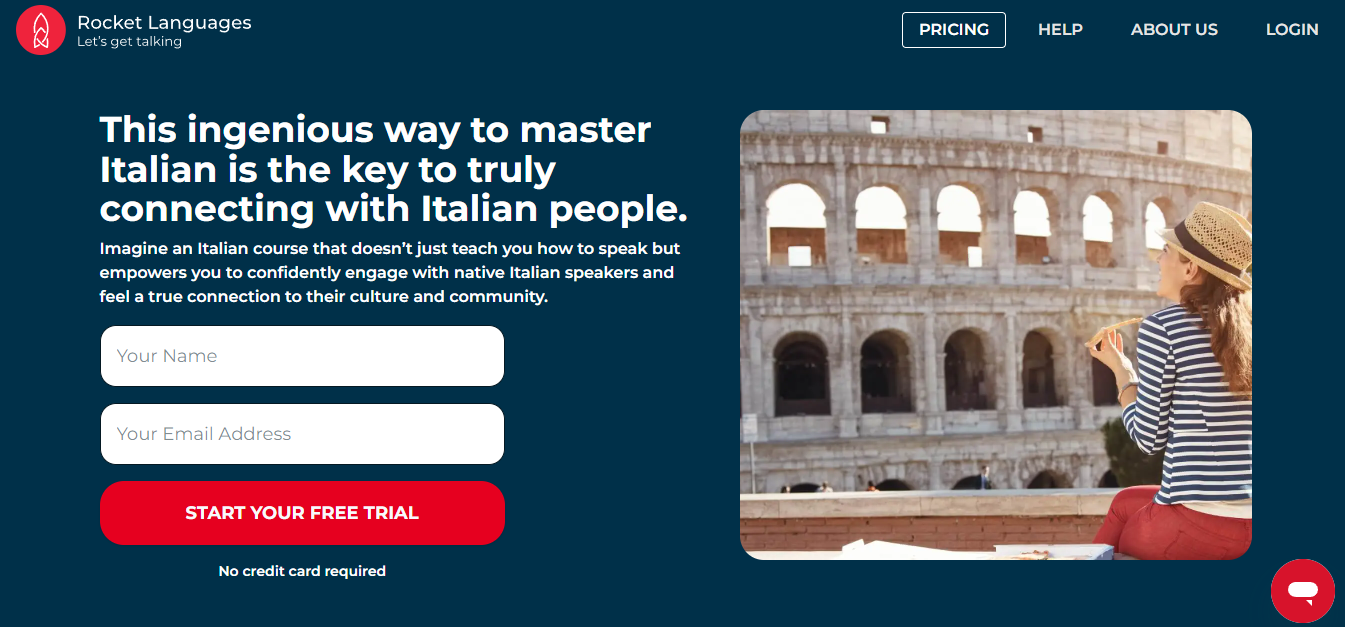
This repeated listing highlights Rocket Italian’s emphasis on cultural dialogues and voice recording tools that allow you to compare your speech with native speakers. The course structure supports long-term progression through recorded audio that you can replay and analyze at your convenience. Consider it again if you value repeated exposure to structured audio lessons.
23. AccelaStudy Italian

AccelaStudy focuses on pronunciation with native-speaker audio and a spaced-repetition dictionary of over 2,000 words, helping you lock in relevant vocabulary and correct forms. Users praise the spaced repetition mechanics that surface troublesome words until they are mastered. Use AccelaStudy when your main gap is consistent recall and accurate pronunciation.
Adoption And Outcomes Matter, Not Just Claims
Code and Cognition reports that over 1.5 million users have downloaded the top Italian learning app, which shows demand and market traction for mobile Italian learning in 2025. And that traction has measurable results, as Code and Cognition found that users reported a 40% increase in language proficiency after using the app for three months, a practical indicator that short, focused practice can deliver tangible improvement.
The Trade-Off: Efficiency vs. Traditional Language Learning Methods
Most learners follow the familiar path of juggling podcasts, flashcards, and occasional conversation practice because that feels attainable and cheap. Over time the cost appears as stalled speaking ability, inconsistent feedback, and wasted hours fixing mistakes that could have been corrected early.
Solutions like Pingo AI provide a bridge, as platforms like Pingo simulate native speakers with ultra-realistic audio, offer Tutor Mode, and deliver over 200 real-life scenarios, providing targeted, actionable feedback that enables learners to compress their time-to-fluency while practicing in low-pressure, repeatable conversations.
Creating a Balanced Language Learning Toolkit
Imagine this list as a toolkit: pick one speaking-first option, one structured course, and one immersion or utility app, then rotate them so you get guided instruction, real conversation practice, and media exposure without burning out. Small, consistent variety beats sporadic intensity.
That progress feels promising, but the real question is how you measure whether an app actually builds usable speaking skills, and that’s where things get surprising.
Related Reading
- Babbel vs Duolingo
- How Much Is Duolingo Max
- How Much Does Babbel Cost
- Rosetta Stone vs Duolingo
- Best Apps to Learn Spanish
- Best Apps to Learn Japanese
- Busuu vs Duolingo
- Duolingo Alternatives
How to Choose the Right App to Learn Italian

Choose the right Italian app by testing whether it forces you to speak, gives corrective feedback you can act on, and fits the time and device constraints you actually have. Pick an app that makes measurable speaking practice the default, not an optional add-on, and then verify that with short, targeted trials before you commit.
What Quick Experiments Should I Run In The First Week?
When we ran four-week pilots with travelers preparing for short trips, the pattern was clear: the apps that made learners speak in controlled, repeatable exchanges produced usable phrases faster than those that only delivered passive input.
Give any candidate app three concrete trials in seven days:
- Start a timed two-to-three-minute spoken exchange that demands a reply
- Check whether the app flags and explains errors in context
- Then repeat the same scenario to see if corrections reappear as practice prompts.
If the app fails any one of those tests, it will likely feel helpful but leave you uncomfortable ordering at a restaurant.
How Do I Measure Real Speaking Progress, Not Just Points?
Measure production, not points. Track the longest uninterrupted time you can hold a roleplay or real dialog, count how many corrected phrases you reuse correctly in new prompts, and record typical pause length before you reply.
Reported outcomes matter:
In a 2023 user survey, 95% of users reported improved language skills, which shows perceived gains when learners focus on active practice rather than passive review. Use short weekly recordings as your benchmark, then compare the same prompt after two weeks to see whether phrasing, timing, and confidence improved.
What Practical Constraints Should Guide My Choice?
Three non-essential constraints determine whether you will continue using an app:
- device reliability
- Offline mode
- The subscription model
Given that in 2023, over 60% of language learners use mobile apps to study, offline playback and low-data recording matter more than glossy UI. Also, check the cancellation terms and whether recorded corrections are exportable, as losing months of spoken practice to a hard-to-cancel subscription is a real sunk cost.
What Typical Trade-Offs Should I Be Prepared To Make?
If you need speed-to-conversation, prioritize speaking-first features and immediate correction, accepting less structured grammar modules. If you want long-term scaffolding to CEFR levels, choose courses with explicit grammar sequencing, which allows for slower speaking gains in the early stages.
The Failure Mode is Predictable
People chase breadth, accumulating vocabulary lists that never find a home in sentences. Treat the decision like buying a tool. Choose the one that does the specific job you need today, not the one that promises a vague future payoff.
Bridging the Gap from Practice to Conversational Fluency
Most people manage their studies by combining short drills, a podcast, and occasional human tutoring because these methods are familiar and low-friction. That familiarity works early, but it creates a hidden cost: hours of practice that do not translate into confident speaking.
Platforms like Pingo’s AI language learning app step in at that point, offering simulated native exchanges, Tutor Mode, and scenario-driven feedback that turn scattered practice into targeted conversational rehearsal, compressing time spent fixing recurring errors.
How Do I Build A Sustainable Practice System Around The App?
- Schedule speaking engagements like meetings you cannot skip.
- Begin with a five-minute spoken warm-up, followed by a focused 10-minute role-play that introduces a new structure, and conclude with a one-minute recording of yourself using the corrected phrasing.
- Treat these as experiments: change one variable each week, either prompt complexity, speaking length, or error-target.
- Also design “failure-tolerant” sessions: practice when you are slightly tired, so honest conversations feel easier.
- Think of the app as a rehearsal studio where you try lines, receive direction, and repeat until the line becomes yours, not a library of words you hope to remember later.
Which Red Flags Should Make You Drop An App Quickly?
If the app never adapts after repeated errors, if speaking is optional, or if corrections are vague, stop investing time. Also, be wary if native audio is thin, or the app treats pronunciation as a checkbox instead of a recurring skill. Those issues create a quiet defeat where you feel you practiced, but you cannot speak.
Pingo: Conversation-First AI for Faster Fluency
Pingo's AI language learning app is redefining language learning through conversation-first practice powered by expressive AI, turning passive reviewing into realistic, feedback-driven exchanges that build usable speaking skills. With adaptive feedback, personalized exercises, and two distinct modes for beginners and advanced learners, Pingo helps you transition from hesitation to fluent, confident conversation more quickly.
Related Reading
- Memrise vs Duolingo
- Best Apps to Learn French
- Lingodeer vs Duolingo
- Pimsleur vs Babbel
- Jumpspeak vs Duolingo
- Best Apps to Learn Mandarin
- Best Apps to Learn Arabic
- Best Apps for Learning English
- Best Russian Learning Apps
9 Best Tips for Learning Italian Quickly

Start by treating these nine practices as a single, speaking-first routine: begin with the alphabet, layer listening and reading, force yourself to speak, and make daily, measurable practice nonnegotiable. Each item below is tactical, tied to a clear behavior you can test this week.
1. Begin With The Italian Alphabet
Learn the 21-letter core and the way each letter sounds in real speech, not just how it looks on a page. Spend short drills on problematic pairs, like how c and g change before e and i, and record yourself saying a short alphabet passage to compare tone and rhythm across attempts. That small habit pays outsized returns later because clear articulation prevents fossilized errors.
2. Watch Italian TV Shows And Films
Pick familiar stories so you can focus on language choices and rhythm rather than plot. Use layered viewing: first watch with Italian subtitles to map sound to spelling, then a second pass without subtitles and pause to shadow short lines. Treat this like a pronunciation lab, not entertainment; note recurrent phrases and replay them until your mouth shapes match native timing.
3. Start Speaking Out Loud in Italian
Conduct two-minute spoken warm-ups every session, where you require full sentences, not single words. Speaking aloud is awkward at first because it exposes gaps, but that friction is the point; think of it as testing a boat in the harbor before you cross open water. If anxiety stops you, shrink the task to one sentence you must repeat three times, then build from there.
4. Spend Time Around Other Italian Speakers
If you cannot travel, seek out regular opportunities for live Italian conversation, such as language tables, community meetups, or conversation partners. According to the Italian Online Academy, 70% of learners find that practicing with native speakers accelerates their language acquisition.
This 2025 finding highlights why live exchange transforms passive knowledge into actionable speech. In practice, aim for short, repeated interactions that allow you to try new phrases and receive immediate corrective feedback.
5. Read Italian Children’s Books
Choose books with repeated structures and predictable plots so you can anticipate language patterns and test them aloud. As you progress, annotate common phrases, then use those phrases in spoken mini-dialogues, so reading feeds production. This strategy reduces overwhelm because the sentences are short and the vocabulary recycles, which is precisely the scaffolding your speaking needs.
6. Focus on The Most Useful Words and Phrases
Target the 200 or so high-frequency phrases you will actually use in daily conversation, not every rarer noun you encounter. Build phrase bundles around specific situations, such as ordering food or asking for directions, and then practice chaining those bundles into short role-plays. That way, vocabulary sits inside action, and you stop memorizing lists that do not translate into speech.
7. Play Video Games With Italian Language Settings
Use story-driven or role-playing games with Italian voiceovers and English UI for comprehension support. Games force you to process speech while making choices, which enhances active listening under low-pressure situations. Capture short lines you like, mimic them aloud, and drop them into a spoken roleplay later, so the game becomes rehearsed, not passive, exposure.
8. Practice Writing In Italian
Write short, functional pieces you will say later: a two-line order, a brief apology, a question you might ask a host. Then speak what you wrote aloud and record it. Writing crystallizes syntax and forces you to make choices you will have to justify in conversation, which tightens your production loop.
9. Make Practice Daily and Measurable
If you want faster gains, practice the metric, not time spent aimlessly reviewing. According to the Italian Online Academy, Learners who dedicate at least 30 minutes a day to language practice improve their skills 50% faster.
This result shows that consistent, focused practice accelerates measurable progress. Turn those 30 minutes into a repeatable routine: two minutes warmup, 12 minutes focused spoken roleplay, 10 minutes targeted feedback and correction, six minutes review.
Beyond Basic Drills: The Need for Realistic and Corrective Practice
Most learners stick to comfortable patterns because they are familiar, and that makes sense; the familiar works at first. However, as conversations lengthen, the familiar approach begins to fragment: practice becomes a collection of disconnected drills, errors repeat without correction, and confidence wanes.
Solutions like Pingo AI expose this hidden cost, and platforms like Pingo replicate realistic native exchanges, offer Tutor Mode, and provide over 200 real-life scenarios, delivering actionable feedback that forces corrected phrases back into practice, converting scattered time into measurable speaking gains.
Breaking the Silence: Rehearsal Strategies for Fluency
It feels risky to speak up and make mistakes, and that fear is real. The pattern is consistent across self-taught and classroom learners, where lack of safe, repeatable rehearsal is the root cause of silence. Push for failure-tolerant sessions, short rehearsals when you are slightly tired, and partners who laugh with you, not at you; those conditions change anxiety into progress.
Think of this list as a single training cycle: brief warmup, layered input, targeted production, immediate correction, and measurable review. Try one change per week, record a two-minute sample at the start and end of the week, and watch which habit actually shortens your pause time and increases phrase reuse.
That last little win feels like progress, but the surprising part comes next and will flip how you schedule everything.
Start Learning A Language with Pingo for Free Today
It’s exhausting when practice feels punitive, conversations end abruptly, and you are left guessing what to fix; that quiet erosion of confidence is why many learners stall. Consider Pingo AI as a low-friction way to test whether more spoken practice works for you, since 90% of users report improved speaking skills within 3 months, and the app already has over 1 million downloads.
Related Reading
- Best Apps for Learning Korean
- Best Apps for Learning Spanish
- Best Apps for Learning Portuguese
- Best Apps for Learning Spanish
- Best Apps for Learning Russian
- Best Apps for Learning German
- Best Apps for Learning English
- Best Russian Learning Apps